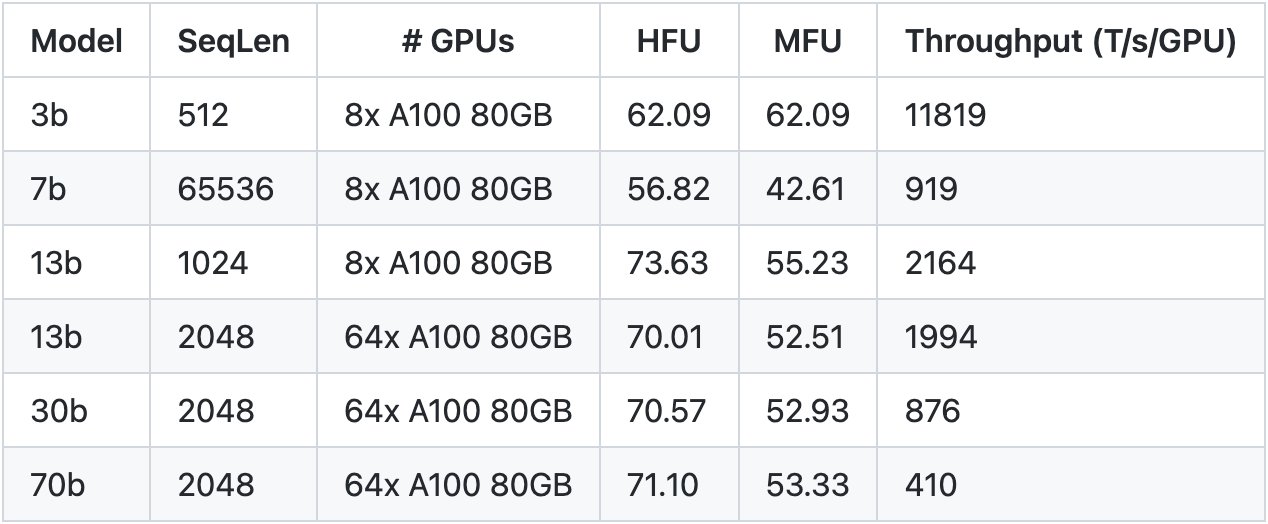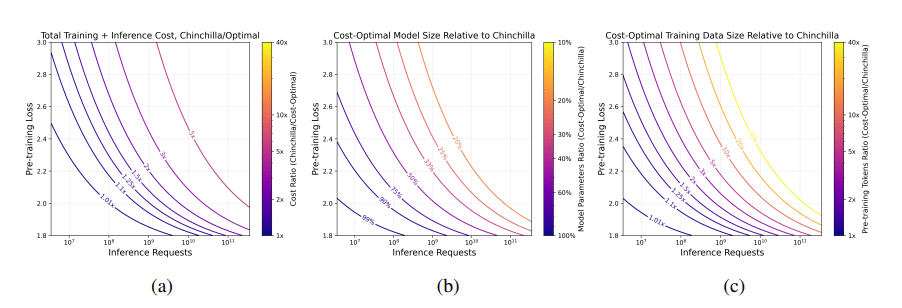CODE 03: MFU 模型利用率评估(DONE)#
Author by: 周浩杰
模型算力利用率(Model FLOPs Utilization, MFU)是评估 AI 模型训练效率的关键指标,它衡量了模型在实际训练中对硬件计算能力的利用程度。
其计算公式为:
要准确计算 MFU,关键在于精确计算模型的 FLOPs。下面我们将分别推导稠密 Transformer 和 MoE 架构的计算公式。
2. 稠密 Transformer 的计算量#

2.1 自注意力机制 FLOPs 计算#
对于单头注意力,计算过程可分为三个部分:
Q、K、V 投影: $\( \text{FLOPs}_{\text{proj}} = 3 \times B \times s \times h \times h \times 2 = 6Bs h^2 \)$
注意力计算(QK^T 和 softmax): $\( \text{FLOPs}_{\text{attn}} = B \times n_{\text{heads}} \times (2 \times s \times h_{\text{per\_head}} \times s) = 2Bs^2 h \)$
输出投影: $\( \text{FLOPs}_{\text{out}} = B \times s \times h \times h \times 2 = 2Bs h^2 \)$
2.2 MLP FLOPs 计算#
标准 FFN 包含两个线性变换和激活函数:
2.3 嵌入层 FLOPs 计算#
2.4 完整稠密模型 FLOPs 公式#
综合所有组件,单次前向传播的 FLOPs 为:
简化后:
考虑反向传播(计算量约为前向的 2 倍),总 FLOPs 为:
3. MoE 架构的 FLOPs 计算#
3.1 MoE 架构的特殊性#
MoE(Mixture of Experts)模型的关键特点:
总专家数:\(E_{\text{total}}\)
每个 token 激活的专家数:\(E_{\text{active}}\)(通常为 1-2)
门控网络计算开销
3.2 注意力部分 FLOPs#
3.3 MLP 部分 FLOPs#
3.4 门控网络 FLOPs#
3.5 嵌入层 FLOPs#
3.6 完整 MoE 模型 FLOPs#
4. FLOPs 计算函数#
def compute_dense_flops(L, h, B, s, V, include_backward=True):
"""
计算稠密 Transformer 模型的 FLOPs
参数:
L: Transformer 层数
h: 隐藏层维度
B: 批次大小
s: 序列长度
V: 词表大小
include_backward: 是否包含反向传播
返回:
total_flops: 总 FLOPs 数
"""
# 前向传播 FLOPs
flops_forward = (
24 * L * B * s * h**2 + # 注意力机制和 MLP 的主要计算
2 * L * B * s**2 * h + # 注意力矩阵计算
2 * B * s * h * V # 嵌入层
)
# 总 FLOPs(前向+反向)
coeff = 3 if include_backward else 1
total_flops = coeff * flops_forward
return total_flops
def compute_moe_flops(L, h, B, s, V, E_total, E_active=2, include_backward=True):
"""
计算 MoE Transformer 模型的 FLOPs
参数:
L: Transformer 层数
h: 隐藏层维度
B: 批次大小
s: 序列长度
V: 词表大小
E_total: 总专家数
E_active: 每个 token 激活的专家数
include_backward: 是否包含反向传播
返回:
total_flops: 总 FLOPs 数
"""
# 注意力部分 FLOPs(与稠密模型相同)
flops_attn = 72 * L * B * s * h**2 + 6 * L * B * s**2 * h
# MoE 特有的 MLP 部分 FLOPs
flops_mlp_moe = 16 * L * B * s * h**2 * (E_active / E_total)
# 门控网络 FLOPs
flops_gate = 2 * L * B * s * h * E_total
# 嵌入层 FLOPs
flops_embed = 6 * B * s * h * V
# 总 FLOPs
total_flops = flops_attn + flops_mlp_moe + flops_gate + flops_embed
return total_flops
让我们通过具体数值来计算 DeepSeek 和 Qwen3 的 FLOPs。
# DeepSeek-7B 参数配置
L_deepseek = 30 # 层数
h_deepseek = 4096 # 隐藏维度
V_deepseek = 102400 # 词表大小
# Qwen3-7B 参数配置
L_qwen = 40 # 层数
h_qwen = 5120 # 隐藏维度
V_qwen = 151936 # 词表大小
# 训练配置
B = 4 # 批大小
s = 512 # 序列长度
# 计算稠密模型 FLOPs
flops_deepseek_dense = compute_dense_flops(L_deepseek, h_deepseek, B, s, V_deepseek)
flops_qwen_dense = compute_dense_flops(L_qwen, h_qwen, B, s, V_qwen)
print(f"DeepSeek 稠密模型 FLOPs/迭代: {flops_deepseek_dense / 1e12:.2f} TFLOPs")
print(f"Qwen3 稠密模型 FLOPs/迭代: {flops_qwen_dense / 1e12:.2f} TFLOPs")
# 计算 MoE 模型 FLOPs(假设 8 个专家,激活 2 个)
E_total = 8
E_active = 2
flops_deepseek_moe = compute_moe_flops(L_deepseek, h_deepseek, B, s, V_deepseek, E_total, E_active)
flops_qwen_moe = compute_moe_flops(L_qwen, h_qwen, B, s, V_qwen, E_total, E_active)
print(f"DeepSeek-MoE 模型 FLOPs/迭代: {flops_deepseek_moe / 1e12:.2f} TFLOPs")
print(f"Qwen3-MoE 模型 FLOPs/迭代: {flops_qwen_moe / 1e12:.2f} TFLOPs")
# 计算 MoE 相对于稠密的节省比例
saving_deepseek = (flops_deepseek_dense - flops_deepseek_moe) / flops_deepseek_dense
saving_qwen = (flops_qwen_dense - flops_qwen_moe) / flops_qwen_dense
print(f"DeepSeek-MoE FLOPs 节省: {saving_deepseek * 100:.2f}%")
print(f"Qwen3-MoE FLOPs 节省: {saving_qwen * 100:.2f}%")
DeepSeek 稠密模型 FLOPs/迭代: 80.14 TFLOPs
Qwen3 稠密模型 FLOPs/迭代: 165.47 TFLOPs
DeepSeek-MoE 模型 FLOPs/迭代: 84.27 TFLOPs
Qwen3-MoE 模型 FLOPs/迭代: 174.06 TFLOPs
DeepSeek-MoE FLOPs 节省: -5.15%
Qwen3-MoE FLOPs 节省: -5.20%
5. MFU 计算完整实现#
def calculate_mfu_comprehensive(model_config, batch_size, seq_length, iteration_time, device_flops, is_moe=False):
"""
综合计算模型的 MFU
参数:
model_config: 模型配置字典
batch_size: 批次大小
seq_length: 序列长度
iteration_time: 迭代时间(秒)
device_flops: 设备峰值 FLOPS
is_moe: 是否为 MoE 模型
返回:
mfu: 模型算力利用率
detailed_breakdown: 详细计算分解
"""
# 提取模型参数
L = model_config['num_hidden_layers']
h = model_config['hidden_size']
V = model_config['vocab_size']
if is_moe:
E_total = model_config.get('num_experts', 8)
E_active = model_config.get('num_experts_per_tok', 2)
total_flops = compute_moe_flops(L, h, batch_size, seq_length, V, E_total, E_active)
else:
total_flops = compute_dense_flops(L, h, batch_size, seq_length, V)
# 计算实际 FLOPS
actual_flops_per_sec = total_flops / iteration_time
# 计算 MFU
mfu = actual_flops_per_sec / device_flops
# 生成详细分解
detailed_breakdown = {
'total_flops': total_flops,
'iteration_time': iteration_time,
'actual_flops_per_sec': actual_flops_per_sec,
'device_flops': device_flops,
'mfu': mfu
}
return mfu, detailed_breakdown
让我们通过具体数值来分析不同架构的 MFU 差异。
# 设备峰值算力(假设 A100 GPU)
device_flops = 312 * 1e12 # 312 TFLOPS
# 模型配置
deepseek_config = {
'num_hidden_layers': 30,
'hidden_size': 4096,
'vocab_size': 102400
}
qwen_config = {
'num_hidden_layers': 40,
'hidden_size': 5120,
'vocab_size': 151936
}
# 假设的迭代时间(基于实际测量)
iteration_time_dense = 0.5 # 秒
iteration_time_moe = 0.3 # 秒
# 计算 MFU
print("DeepSeek 模型 MFU 分析:")
mfu_deepseek_dense, breakdown_dense = calculate_mfu_comprehensive(
deepseek_config, 4, 512, iteration_time_dense, device_flops, False
)
mfu_deepseek_moe, breakdown_moe = calculate_mfu_comprehensive(
deepseek_config, 4, 512, iteration_time_moe, device_flops, True
)
print(f"稠密架构 MFU: {mfu_deepseek_dense * 100:.2f}%")
print(f"MoE 架构 MFU: {mfu_deepseek_moe * 100:.2f}%")
print(f"MFU 提升: {(mfu_deepseek_moe - mfu_deepseek_dense) / mfu_deepseek_dense * 100:.2f}%")
# 输出详细计算信息
print("\n 详细计算分解(稠密):")
for key, value in breakdown_dense.items():
if 'flops' in key:
print(f"{key}: {value / 1e12:.2f} TFLOPs")
else:
print(f"{key}: {value}")
print("\n 详细计算分解(MoE):")
for key, value in breakdown_moe.items():
if 'flops' in key:
print(f"{key}: {value / 1e12:.2f} TFLOPs")
else:
print(f"{key}: {value}")
DeepSeek 模型 MFU 分析:
稠密架构 MFU: 51.37%
MoE 架构 MFU: 90.03%
MFU 提升: 75.25%
详细计算分解(稠密):
total_flops: 80.14 TFLOPs
iteration_time: 0.5
actual_flops_per_sec: 160.29 TFLOPs
device_flops: 312.00 TFLOPs
mfu: 0.5137441650215384
详细计算分解(MoE):
total_flops: 84.27 TFLOPs
iteration_time: 0.3
actual_flops_per_sec: 280.90 TFLOPs
device_flops: 312.00 TFLOPs
mfu: 0.9003342401641026
不同条件下的 MFU 分析
def analyze_mfu_variations(model_config, device_flops, is_moe=False):
"""
分析不同批大小和序列长度对 MFU 的影响
参数:
model_config: 模型配置
device_flops: 设备峰值 FLOPS
is_moe: 是否为 MoE 模型
"""
import matplotlib.pyplot as plt
import numpy as np
# 测试不同的批大小和序列长度
batch_sizes = [1, 2, 4, 8, 16]
seq_lengths = [256, 512, 1024, 2048]
# 假设迭代时间与计算量成正比
base_time = 0.3 if is_moe else 0.5
results = np.zeros((len(batch_sizes), len(seq_lengths)))
for i, bs in enumerate(batch_sizes):
for j, sl in enumerate(seq_lengths):
# 估算迭代时间(与实际计算量成正比)
if is_moe:
flops = compute_moe_flops(
model_config['num_hidden_layers'],
model_config['hidden_size'],
bs, sl,
model_config['vocab_size'],
8, 2
)
else:
flops = compute_dense_flops(
model_config['num_hidden_layers'],
model_config['hidden_size'],
bs, sl,
model_config['vocab_size']
)
# 假设迭代时间与 FLOPs 成正比
iteration_time = base_time * (flops / (312 * 1e12)) # 归一化
mfu, _ = calculate_mfu_comprehensive(
model_config, bs, sl, iteration_time, device_flops, is_moe
)
results[i, j] = mfu
# 可视化结果
plt.figure(figsize=(12, 5))
# 批大小对 MFU 的影响
plt.subplot(1, 2, 1)
for j, sl in enumerate(seq_lengths):
plt.plot(batch_sizes, results[:, j], 'o-', label=f'SeqLen={sl}')
plt.xlabel('Batch Size')
plt.ylabel('MFU')
plt.title('MFU vs Batch Size')
plt.legend()
plt.grid(True)
# 序列长度对 MFU 的影响
plt.subplot(1, 2, 2)
for i, bs in enumerate(batch_sizes):
plt.plot(seq_lengths, results[i, :], 'o-', label=f'BS={bs}')
plt.xlabel('Sequence Length')
plt.ylabel('MFU')
plt.title('MFU vs Sequence Length')
plt.legend()
plt.grid(True)
plt.tight_layout()
plt.show()
return results

6. 技术原理深度解析#
MoE 架构的核心思想是通过稀疏激活来减少计算量:
当 \(E_{\text{total}} = 8\) 且 \(E_{\text{active}} = 2\) 时,MLP 部分的计算量减少到原来的 25%。
实际 MFU 通常低于理论值的主要原因:
内存带宽限制:数据搬运时间占比较大
通信开销:分布式训练中的梯度同步
计算并行度:无法完全利用所有计算单元
内核启动开销:GPU 内核启动的延迟
7. 总结与思考#
通过公式推导和代码实现,我们深入分析了稠密和 MoE 架构的 FLOPs 计算原理。稀疏激活,MoE 架构可以显著减少计算量,通常能节省 50-75%的 FLOPs,虽然 MoE 减少计算量,但需要权衡通信开销和内存使用。
另外,为了提高 MFU 需要综合考虑计算、内存、通信三个方面的综合优化。